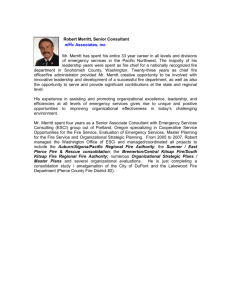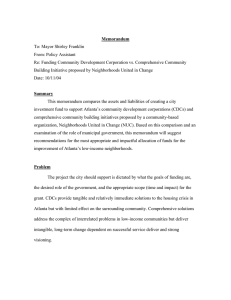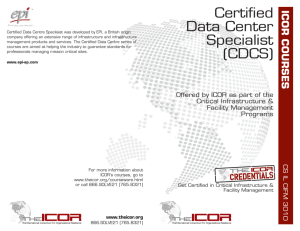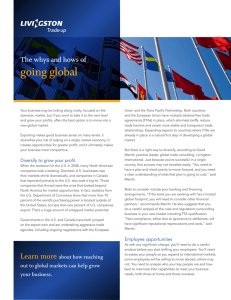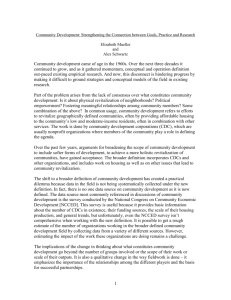Community Development Corporations and Neighborhood Revitalization Urban Institute Christopher Walker ,
advertisement
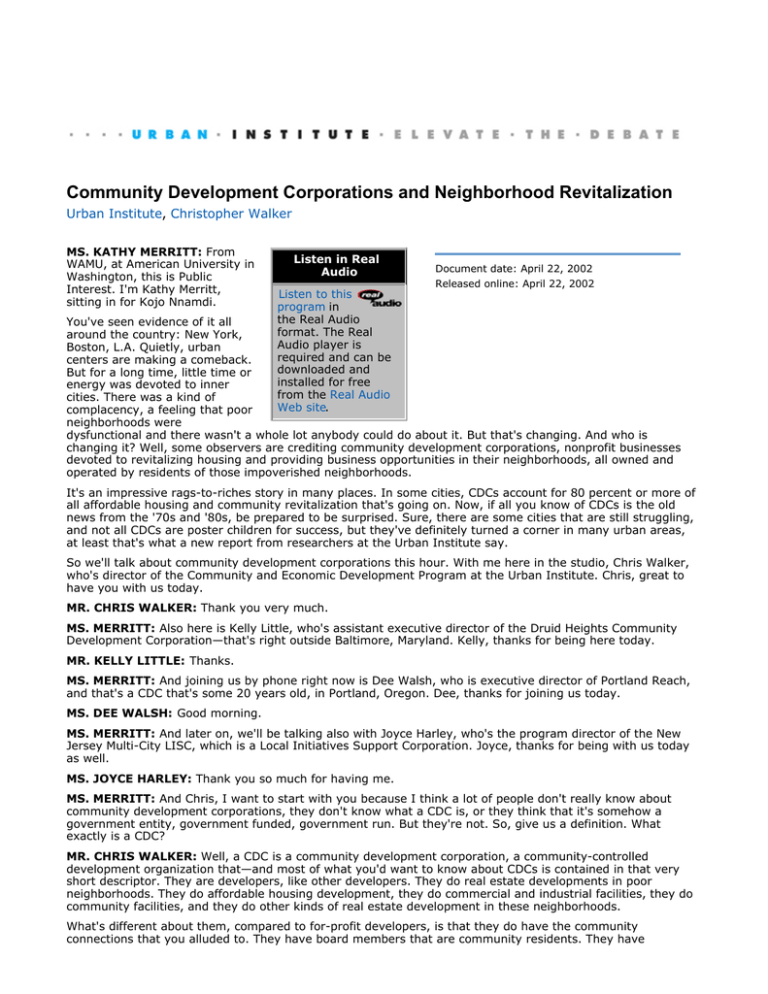
Community Development Corporations and Neighborhood Revitalization Urban Institute, Christopher Walker MS. KATHY MERRITT: From WAMU, at American University in Washington, this is Public Interest. I'm Kathy Merritt, sitting in for Kojo Nnamdi. Listen in Real Audio Document date: April 22, 2002 Released online: April 22, 2002 Listen to this program in the Real Audio format. The Real Audio player is required and can be downloaded and installed for free from the Real Audio Web site. You've seen evidence of it all around the country: New York, Boston, L.A. Quietly, urban centers are making a comeback. But for a long time, little time or energy was devoted to inner cities. There was a kind of complacency, a feeling that poor neighborhoods were dysfunctional and there wasn't a whole lot anybody could do about it. But that's changing. And who is changing it? Well, some observers are crediting community development corporations, nonprofit businesses devoted to revitalizing housing and providing business opportunities in their neighborhoods, all owned and operated by residents of those impoverished neighborhoods. It's an impressive rags-to-riches story in many places. In some cities, CDCs account for 80 percent or more of all affordable housing and community revitalization that's going on. Now, if all you know of CDCs is the old news from the '70s and '80s, be prepared to be surprised. Sure, there are some cities that are still struggling, and not all CDCs are poster children for success, but they've definitely turned a corner in many urban areas, at least that's what a new report from researchers at the Urban Institute say. So we'll talk about community development corporations this hour. With me here in the studio, Chris Walker, who's director of the Community and Economic Development Program at the Urban Institute. Chris, great to have you with us today. MR. CHRIS WALKER: Thank you very much. MS. MERRITT: Also here is Kelly Little, who's assistant executive director of the Druid Heights Community Development Corporation—that's right outside Baltimore, Maryland. Kelly, thanks for being here today. MR. KELLY LITTLE: Thanks. MS. MERRITT: And joining us by phone right now is Dee Walsh, who is executive director of Portland Reach, and that's a CDC that's some 20 years old, in Portland, Oregon. Dee, thanks for joining us today. MS. DEE WALSH: Good morning. MS. MERRITT: And later on, we'll be talking also with Joyce Harley, who's the program director of the New Jersey Multi-City LISC, which is a Local Initiatives Support Corporation. Joyce, thanks for being with us today as well. MS. JOYCE HARLEY: Thank you so much for having me. MS. MERRITT: And Chris, I want to start with you because I think a lot of people don't really know about community development corporations, they don't know what a CDC is, or they think that it's somehow a government entity, government funded, government run. But they're not. So, give us a definition. What exactly is a CDC? MR. CHRIS WALKER: Well, a CDC is a community development corporation, a community-controlled development organization that—and most of what you'd want to know about CDCs is contained in that very short descriptor. They are developers, like other developers. They do real estate developments in poor neighborhoods. They do affordable housing development, they do commercial and industrial facilities, they do community facilities, and they do other kinds of real estate development in these neighborhoods. What's different about them, compared to for-profit developers, is that they do have the community connections that you alluded to. They have board members that are community residents. They have advisory committees, or other ways of connecting into the opinions and values of people who live in the neighborhood. And the kinds of people who go into this business are people who dedicate themselves to improving neighborhoods on behalf of communities, so there is a community connection. And that leads them to do developments which are different from the kinds of developments that the public sector might do on their own, through a public housing agency, for example, or that a for-profit developer might do. MS. MERRITT: So, they're really closer to the needs and wants of that community, and try to make those come true somehow. MR. WALKER: Yes. And what is also important to know about community development corporations is, what makes them different from other community-based organizations? There are a lot of community-based organizations that do social services, that do things like soup kitchens, or family services, or youth programs, and other kinds of activities. But what makes community corporations particularly important in neighborhoods is that they command a lot of assets. They often own property. They own and manage rental units. They participate actively in a lot of the land-use decisions that get made in neighborhoods. And I think it's fair to say that land use is a core of an issue, in some ways. And community development corporations are very well positioned to speak for the community on issues of major importance. And I think that gives them a clout in city hall, and a power which is not matched by other community-based organizations. MS. MERRITT: Well, Dee Walsh, let me ask you about Portland Reach. As I mentioned, in introducing you, it was far more than 20 years ago. Tell us what motivated you, and what was your neighborhood like when Portland Reach first came together 20 years ago? MS. WALSH: I wasn't actually involved with Reach at the time, but I can tell you that in the early 1980s, there was a lot of disinvestment in the inner cities. And a group of neighborhood residents got together in inner southeast Portland and decided they wanted to do something, because the schools were closing, families were leaving the area, old Victorian houses were being torn down, and they wanted to attract families back into the area to keep the schools. So, they incorporated as Reach Community Development, with the primary purpose of developing and revitalizing the housing in the neighborhood. MS. MERRITT: And so, has that happened? Has there been positive change along the way? MS. WALSH: There's been a great deal of change over the last 20 years. Reach itself has gone from a very small, shoestring operation. Today, we have over a $3.5 million budget and 45 employees, and we've developed nearly 800 units of housing, and that's everything from single-family homes to large multifamily buildings. We've also been involved in a couple of different commercial district revitalization programs, and worked very closely with the small businesses in the area. During the last decade, we've seen a lot of gentrification in the neighborhood, and it's been very helpful that we purchased a lot of property in the '80s, because we were able to maintain some affordable housing in parts of our community that are now very, very expensive. MS. MERRITT: So as these 20 years have elapsed, the time that Portland Reach has been an organization, did you really have to sell this idea, in some way? Was there any opposition in Portland, or did people realize right away the value that this kind of a grassroots organization could have? MS. WALSH: Well, Portland lagged behind the rest of the country, or maybe not just Portland, but the Northwest, in terms of the concept of community development corporations, which I think were a growing concern in the East, in the '70s. And so, when Reach first started, there were a lot of questions. People didn't really understand a nonprofit that would develop real estate. It was a foreign concept both, I think, to city government, and also to the foundations. So, of course, we had to prove ourselves. Initially, properties were financed with seller financing, at outrageous interest rates. And when I came in, in the late '80s, early '90s, I spent a lot of my time refinancing those early deals to make them more reasonable. MS. MERRITT: Well, Kelly Little, let me turn to you and the Druid Heights Community Development Corporation. Tell us about your CDC and what's happened. It's really been around for almost 30 years, although it was incorporated back in 1989. Give us a little snapshot of what your CDC has been able to do. MR. LITTLE: Well, the community of Druid Heights is located in Baltimore, and it's right outside of the downtown core. And the community really was impacted by the '68 riots and the civil disturbance of the '60s, and it really saw a lot of out-flight out of the community, and a lot of deterioration through the '70s and '80s. And the community association was actually formed in the early '70s because of civil rights. However, though, the organization really focused on doing things like beautification, planting trees, block cleaning clubs, those sorts of things. However, the community continued to deteriorate around these people who were investing their time and trying to do things to improve the community. So in the late '80s, it was determined a stronger tool needed to be put together to really deal with the blight that was really occurring in the community, and all the social ills that were impacting the community. So the CDC was actually formed in '89 and really took hold in the early '90s. And really, we've been working on land issues, like has been stated before, and really trying to look at the economics of the community through housing and through business development, and those sorts of things, to really bring back the community. MS. MERRITT: Have you been successful? MR. LITTLE: I think we have. We have been successful. We've done a good job in developing new housing units and managing housing units, and we really started focusing on some areas of business development in the last few years. But what I will say is, I think one of the important things that we've found is that you can do the housing development, you can do the economic development, but we've still found that the human capital—and a development of human capital was the key to turning around the community. And we have been putting a lot of effort in really dealing with the people that are there, of the people that are living in the community, and try and improve their plight and life. And really, that's what we understand by improving the plight of the residents that are currently there—that's really going to make a change for the community. MS. MERRITT: Well, what sorts of things have you done to try to invest in that human capital? MR. LITTLE: One of the things we've done is we're part of what's called the Maryland Reentry Program, and that's a program that's a partnership with the City of Baltimore and the State of Maryland's Department of Corrections. And we are actually working with the Department of Corrections on ex-offenders who are coming back to our community. And we have a partnership where our case managers actually go in to the jails, three months prior to the offender's release, and build a relationship. We develop a case management plan, and when they're-released, we're there to pick them up at the prison. When they come home, we work with them, from housing to job placement, employment, education—all sorts of things. A lot of the stuff may have started while they were in jail or, as we say, behind the fence, and we try to continue that once outside of the fence. And what that has done is a number of things. We provide economic opportunity for a lot of individuals who were in a community. A lot of times, they were the problem in a community, whether it was drug dealing, drug addiction, whatever. But now, we've brought them back to the community in a positive way. But we're monitoring them for two years. And what that also does is now, people who are still in the community that knew this person as a drug dealer or a drug addict sees them on the right path. And they start saying, well, what can I do that that person's doing, you know—so they seem to turn their life around. So, also, this ties together comprehensively social service programs and the development. Because we've got a construction company, and a lot of these guys are working on a construction company. MS. MERRITT: Well, I'm sitting here thinking, "Boy, okay, there's a program, and a construction company, and we're talking about building affordable housing." And you know, Chris Walker, it sounds like CDCs are, you know, they're much more than just a narrowly focused kind of organization that looks at building housing in a community. They're really trying to rebuild lives, in a lot of ways. MR. WALKER: Well, that's certainly an important point that Kelly made. It is true that 90 percent of CDCs do some kind of housing development. That's always been their stock in trade; that's not necessarily where they began back in the '60s, but that's certainly where they wound up in the '70s and '80s. Our research, undertaken for the National Community Development Initiative, shows a diversifying agenda among CDCs that's been very well supported throughout the 1990s. We did a survey of some of the better CDCs in terms of their operating budgets and the number of staff in 23 cities around the country. And that survey showed that about half of the CDCs were doing some sort of workforce development or youth development programming. I don't think that would have been true at the beginning of the 1990s. MS. MERRITT: So I guess that goes back to what we were talking about earlier, is that the CDCs are close to the ground, so they can assess the needs in their particular community. MR. WALKER: But it's easy enough to assess needs. Not all CDCs do it perfectly, but most CDCs do it well. What is important, however, is that CDCs need to gain external support from major institutions outside the neighborhood in order to carry out these programs. The kinds of developments that CDCs do, they're very blighted properties in poor neighborhoods, for low-income people who can't pay market rent. They don't generate the kind of income that CDCs need in order to pay for these other kinds of activities. So critical is government support, is bank support, is support from local foundations in order to carry out this broad agenda. MS. MERRITT: Okay, we'll be talking more about the broad agenda of community development corporations after we take this short break. Stay tuned. (Break) MS. MERRITT: Welcome back. This is Public Interest. I'm Kathy Merritt, sitting in today for Kojo Nnamdi. We're talking about community development corporations, and our guests this hour are Chris Walker, director of the Community and Economic Development Program at the Urban Institute; Kelly Little, who is with the Druid Heights Community Development Corporation; Dee Walsh, executive director of Portland Reach; and Joyce Harley, who's program director for the New Jersey Multi-City LISC, that's Local Initiatives Support Corporation. Please join our conversation by calling us at 1-800-433-8850, or e-mail us at pi@wamu.org. Just before the break, Chris, we were talking about a study that the Urban Institute spent a number of years doing, looking at CDCs in 23 cities. As you said, you found a lot of commonalities, but was there anything in the study that at CDCs in 23 cities. As you said, you found a lot of commonalities, but was there anything in the study that surprised you? MR. WALKER: I think I was surprised to see that the claims of the industry advocates, those who had been supporting CDCs throughout the—what now seems to be the dark decades of the '70s and '80s, were right. And I came into this study in 1994, largely as a skeptic of nonprofit-sponsored community development, and was very surprised to see how much progress had been made in the late '80s and the early 1990s, and indeed continued throughout the 1990s. Our study was supported by the National Community Development Initiative, which was a unique effort on the part of national corporations, private foundations, and the U.S. Department of Housing and Urban Development, to put money into community development corporations around the country, in hopes of rapidly increasing their capacity to improve their neighborhoods. But what was important about this initiative, and the some $250 million that they pooled to support CDCs, was not that they were simply investing in CDCs as organizations, but rather, they were investing in local institutions to continue to support these corporations after the NCDI went away. And by that, I mean this, that the local foundations, local banks, local corporations, and city government could just as well pool their own funding into new operating support collaboratives that would support community development corporations in their work, just as the national funders had come together to pool their own funding to support the work being done in 23 cities. So they were engaged in what might be called system building, that is they just didn't want to improve individual organizations; they wanted to create whole networks of institutions that could support community development corporations over the long term. And over the period of the 1990s, we saw spectacular increases in the amounts of money channeled through CDCs. We saw an approximate doubling of the amounts of total development that were being pushed out the door by CDCs, until our last figure, the year 2000, shows it to be a billion-dollar industry in these 23 cities alone. So I was impressed. We went out and spent a lot of hard work to acquire as much of the empirical documentation as we could of the CDC effort. And further, I think one of the most important things we learned is that the best of social science can indeed determine that CDCs have had impacts in neighborhoods. There has been, over the years, some doubt about that, that CDCs really weren't strong enough on their own to turn residential markets around. We did exploratory analyses in five different neighborhoods in Portland, Oregon—Dee's group, Reach—in Oakland, California, in Cleveland, in Denver, and in Boston, and discovered that, indeed, we were able to put a dollar value on the CDC contribution to increases in property values in neighborhoods, increases in property values understood as a market signal of how people value the quality of life in that neighborhood. So, put another way, we have conclusive evidence that CDCs had indeed contributed to the quality of life of neighborhoods. It's very difficult to do that. Social science doesn't have a good track record on that score, but I think it's a testament to the success of the CDCs in these neighborhoods that we were able to document so thoroughly the value that CDCs had. MS. MERRITT: Well, you mentioned the collaborators—sort of new level of organizational support for CDCs, and that's where I want to bring Joyce Harley into this conversation, because she is program director of a LISC, and that's a well-known term in these circles. It's a Local Initiatives Support Corporation. Joyce, tell us a little bit about how these different collaborators work, and what does a LISC like yours do? MS. HARLEY: Well, we're, in essence, the turnaround specialists, and we're an intermediary. We pool these resources from these collaborators, the foundations, the corporations, individual investors, and governmental agencies, to provide financial and technical assistance and support to the very CDCs that we've been describing. We've always known and believed exactly what Chris's study discovered, that CDCs really do make a difference in neighborhoods that are in the process of turning around and becoming revitalized, and better, healthier places for people to live. MS. MERRITT: And so, how do you do that, though? I mean, what sort of help and advice or encouragement do you offer a CDC? MS. HARLEY: It's a variety of things. First of all, the financial support to bring the first dollars into these development transactions, the more risky dollars, the dollars that help the organization build their capacity. We firmly believe in the ability of CDCs to deliver, and we know that you need strong, healthy CDCs to enable them to do that. So, we work with their staff and their boards to make sure that they understand the development process, the revitalization process. We provide technical assistance so that they can help develop a plan once they've defined the neighborhood, and based on the needs that the community has expressed, have worked out a way to address those needs. We've put the riskier dollars in place, the predevelopment money, the money that assess[es] whether or not—first of all, acquires the site and assess[es] whether or not the site is buildable. So that's what we do on the front end with the capital resources that we bring to the table. And the technical assistance is in the training and working with their local governmental entities to help them understand the development process, and understand the tools that are available to them to make development happen, and make neighborhoods stronger and healthier, and more vital. MS. MERRITT: Well, Kelly, let me ask you. It sounds, in some ways, like you have to be a real entrepreneur or somebody with an MBA degree or, you know, somebody with tremendous business savvy to be involved in a CDC. And if you have an organization like Joyce's involved, that must help. But how do you just get up and running, especially working with people who may not have that kind of expertise required to get a CDC really operating successfully? MR. LITTLE: That is a major challenge for a lot of neighborhood groups that find themselves trying to build CDCs, is really bringing in the experience that's needed to do these type of deals. And you do need a lot of experience to get these types of deals done. And intermediaries are critical; partnerships are critical in general. We could not do what we do as a CDC without the strong partnerships that we have with the intermediaries, with financial institutions, those sorts of things. But it's also—one of the big things is training. And I really think it's critical for staff members, neighborhood residents who get involved with the CDCs, being on boards or however, to really get out there and train and learn. There's a learning curve. A lot of times, we find ourselves getting into new areas. My background was real estate development, but when we started doing different economic development things, well, we couldn't just bring in an economic development person that had the experience and that we could afford to pay for. So I had a learning curve to start learning different things about areas of economic development that went beyond the real estate development background that I had. So you really have to go out there and sort of educate yourself and utilize those partnerships with those intermediaries so, hopefully, they can bring in some experience. And you know, you sort of learn as you go. And at some point when you get things up and running and you invest wisely in some of the deals that you do, then maybe you have the income flow that you can then bring on someone that has greater expertise that can then take it to the next level. MS. MERRITT: Do you find that often a CDC needs a really strong leader at the beginning? You've got to have somebody who's kind of charismatic and who's the real true believer who's going to lead everybody. MR. LITTLE: You really do. You need someone that can understand and work within a community. A lot of times, it's community residents. A lot of times, people in a lot of disinvestor communities have a hard time accepting or believing that things are going to change and happen. So, they need someone that they can relate to. But at the same time that person has to be able to deal with the business community, has to be politically savvy. So you really need a dynamic person that can really deal with all different worlds, and sort of jump from one circle to the next to really get things done. And that's critical. That's a very important role in the development of a CDC, is really having that dynamic individual. MS. HARLEY: I can underscore that more. When LISC goes into a community—now, we're in 38 program areas around the country, 68 rural communities—we look for exactly that, the development of local leadership, with a vision, and bring the resources to the table so that they can work with all of the partners that we bring to the table as well. It's not just the money, although that's certainly important. It's the vision and the grassroots leadership, and the ability to manage a lot of different aspects of development, and that's where we believe our expertise is. MS. MERRITT: Well, Chris, let me ask you, just sitting here listening. You know, I would think CDCs are just the greatest thing since sliced bread, but there must be some downside that some communities see. Not every CDC is going to work. Did your study find that as well? MR. WALKER: Oh, of course. And just as a small business, generally speaking, is an uneven sector, there are very strong small businesses, some aren't so strong, and the same is true in community development as well. I think in some important ways, as I alluded to before, the deck is stacked against this kind of enterprise. These are not moneymaking developments. These are not easy neighborhoods to work in. It's not always easy to find people who have the kind of leadership that we were just talking about to lead these organizations. It's not always easy to find staff who are technically competent, who can step in and are willing to accept the kind of challenges that you face day in and day out working in a CDC environment. So, you know, not all CDCs succeed, clearly. But I think it's important to note that the sector, as a whole, has done much, in the 1990s, to overcome some of the chronic difficulties that afflicted it. These organizations, historically, have been undercapitalized. As I mentioned, there are organizations that have had a difficult time attracting talent and keeping it. And I think the good work done by the Local Initiatives Support Corporation and the Enterprise Foundation, which is the other major national intermediary, and the creation of these local operating support collaboratives, funders-collaboratives, have done a lot to try to backstop CDCs as they face the kinds of challenges that are endemic to working in tough neighborhoods. MS. MERRITT: That's Chris Walker, who's director of the Community and Economic Development Program for the Urban Institute. Also on our panel today, Kelly Little with the Druid Heights Community Development Corporation; Dee Walsh, executive director of Portland Reach; and Joyce Harley, program director of the New Jersey Multi-City LISC. You can join us at 1-800-433-8850. This is Public Interest. I'm Kathy Merritt. Let's take a quick phone call, and go first to Vincent, who's here in Washington, D.C. Hi, Vincent. Q: Hi, Kathy, how are you? MS. MERRITT: Good. Thanks for calling today. Q: Thank you for taking my call. You know, again, someone was right in terms of the CDC being the best thing since sliced bread. But my concern about the CDC is that it purports to help the community with this whole revitalization and bringing affordable housing into the area, but a lot of times, the community is really on the margins of it. Because what you see happening is you have these CDCs coming into these urban areas and they actually—the programs are not accessible to the people who are already there. And what you have is people who don't even live in the neighborhoods actually come into the neighborhoods and live in the very neighborhoods that are supposed to help the people who are already there, but those people actually get moved out. So, I'm wondering if the panel can— MS. MERRITT: Sure. Well, we'll address that question. Dee Walsh, let me ask you: Did that happen in Portland at all? Did some people get actually pushed out by a new development that Portland Reach might be undertaking? MS. WALSH: I would say no. And I think part of that is that, as I mentioned earlier, we bought a lot of our property before the real estate value started going through the ceiling in the '90s, and also before our neighborhood started experiencing gentrification. I think it's a good question in that, certainly, if you're in a community that is experiencing gentrification, it's very difficult, because you have to balance your revitalization efforts to make sure that you're able to keep the folks who are currently there, there, and not have them moved out because of the pressures of the real estate market. And I think that a lot of that pressure is really caused by external matters that the CDC can't control. But certainly, any developments that we do are for the people who currently live in our neighborhood and for the people with little resources. MS. MERRITT: Kelly, what about in Druid Heights? Did you see that happen at all? MR. LITTLE: Well, we're not at the point yet where we're seeing the gentrification happen yet. But I think it's important to the caller's point of getting neighborhood residents involved. I think part of the mission of the CDC—you know, if I hear there's a CDC being developed and neighborhood residents aren't a critical part of that development, then I don't know if it really fits the true definition of a CDC. I mean, if people feel—it's almost like a grassroots effort that has to at least start with community residents. You might have to bring in expertise in different areas, and those sorts of things, but you really want the people in the community to be involved in the development of the organization, I think, to make it truly effective. MS. MERRITT: Let us hear your questions at 1-800-433-8850. And let's hear next from Daniel, who's calling from Rockville, Maryland. Daniel, thanks for your call, and thanks for holding. Q: You're welcome. I was wondering if they only do the projects in rural areas, or like in suburban and urban— MS. MERRITT: Okay, thanks for the question. MS. HARLEY: As I said, LISC operates in 38 urban program areas and 68 rural communities. The caller's question is, do we work with CDCs in rural areas? And the answer is absolutely yes. In New Jersey, we're in 14 cities, some of them are rural, some of them are urban, and some of them may even fit the definition of a suburban community, where there is a population or a neighborhood that's in need of revitalization or that's distressed. MS. MERRITT: Okay, and Chris, in your study, did you find kind of a mix of urban and rural? MR. WALKER: Well, our study was focused only on urban areas. But every four years, or three years, or some number of years, the National Congress for Community Economic Development does a census of CDCs; we assisted with the last one. Back in '97, CDCs had built about 550,000 housing units since their beginning back in the '60s. And most of those units were done in the '90s, and about 21 percent of them, a fifth, were in rural areas. So it's still largely an urban phenomenon. I know that LISC has been aggressively pursuing an expanded capacity in rural areas. And I suspect that when we do the study again, if we do the study again, we'll find that that number will go up. MS. MERRITT: Okay. Well, we're going to continue our conversation about community development corporations after we take a short break. And, of course, we'll continue to take your phone calls, at 1-800-433-8850, or drop us an e-mail at pi@wamu.org. Stay tuned. (Break) MS. MERRITT: Welcome back. I'm Kathy Merritt, and this is Public Interest. We're talking today about community development organizations, or rather, I should say corporations. And in the studio with me, Chris Walker of the Urban Institute, Kelly Little, who is with the Druid Heights Community Development Corporation. On the phone, Dee Walsh, executive director of a CDC in Portland, Oregon, called Portland Reach, and Joyce Harley is program director for the New Jersey Multi-City LISC. And LISC stands for Local Initiatives Support Corporation. Join us at 1-800-433-8850. And let's get back to the phones and hear from a caller in Washington, D.C. And let me get your name. Is it Memo? Q: Memo, yes. Hi. I have a question about the responsibilities of CDCs in neighborhoods. I live in Bloomingdale here in Washington, D.C., which is right next door to LeDroit Park, right near Howard University. And the People's Involvement Corporation, which was part of a huge report—rather, that the Washington Post did, and they found that they had about 17 or 20 projects, most of which were uncompleted, even though the city spent millions and millions of dollars. The more particular property we have is an old vacant school that they petitioned the community about eight years ago, seven years ago, to turn it into 62 senior condos, or rather, apartments. And now, the school sits vacant, was just recently sold to Howard University. My question is, who is held responsible for a CDC, which is well connected and well funded, when they fail? Howard University has purchased a property, and they need dorm space, so this is going to be turned into a dorm. And what we really need is senior housing in this neighborhood. We don't have an issue much with it being a blighted area, so the CDCs have never really brought our neighborhood out of that. So, you know, it's this kind of a bait and switch with them. Can your panel address that? MS. MERRITT: Absolutely, and we appreciate the question. And I'll just make a note to our local listeners in Washington that we'll be doing a separate show on local CDCs in the Washington area, because unfortunately, it's kind of a mixed bag here in the Washington area. But Chris, what happens when a CDC doesn't work? MR. WALKER: Well, I think the issue the caller raised is an artifact of the failed model of the past. And if I could describe that briefly, it was a situation where CDCs did what they did in neighborhoods, largely supported by city government, and not by much else, and maybe, maybe not had strong ties in the community, but didn't consider themselves particularly accountable to the community as they did their work. And what we've seen happen at least in the 23 cities we looked at over the last seven years is a rise in new forms of accountability that are represented by these new funding collaboratives. And what has happened is that foundations, banks, even city governments have changed the way they fund community development corporations, away from writing small grants to individual applicants year after year after year, so that a CDC will get $10,000 from this bank and $10,000 from this corporation, and $50,000 from the local government. What the funders will do is pool their money and make it available in bigger chunks. We'll write you a $150,000 check to cover three years, or maybe, more often, larger amounts. But we're not just going to give you the money. We're going to hold you accountable for results. And so, the money comes with strings attached. And in this case, strings attached is a good thing. A lot of operating support collaboratives, the best ones anyway—and by the way, Washington has a very good one—will only give support to community development corporations after a consultant has come in and done an organizational assessment. And the CDC will do a work plan for organizational improvement, as well as project production. And at the end of the three-year grant period, or two-year grant period, or whatever amount of money they've received their funding for, they are held accountable for a result. And if they appear not to have taken seriously their commitment to the neighborhood and commitment to the work plan that they've negotiated with the funders, they'll be cut off. The problem in Washington, which I know you'll talk about in another show, is that the city government continues to fund CDCs without much regard to their performance outside of the new institutional arrangement. So a part of the old way still is in place. And until the city deals with that, these kinds of accountability problems—there's a risk that these will continue. MS. MERRITT: Let me ask Kelly and Dee, do you and your CDCs feel that sense of responsibility, of fiduciary responsibility, Kelly, that you know, if you don't perform, the money's not going to be there, you can't serve the people you're set up to serve? MR. LITTLE: Yes, I do. In 10 years, I've been doing this for 10 years, and I can say the early '90s, you know, we could go out and do a deal and sort of go out, submit for the financing, and we could get it pretty easily. And within the last 10 years, it's become so competitive now that you just can't go and say you want to do a deal, and put together a good deal. But you really have to show, through your experience, that you've had some success. Even all the foundations now—the thing is evaluation. Everyone wants to know how you can evaluate your project, sustainability. If you do something, how is it going to continue to last when that foundational funder goes away? So, a lot of emphasis is really looked upon there—what happens after you do it? I think, for a while, it was just to be able to do something was okay. But now, it's really about, what is the impact, and how are you going to be able to operate it or manage it, and you've got to be able to show that and prove that. MS. MERRITT: And Dee Walsh, that's true in Portland as well? MS. WALSH: Yes, I think that we've always been held accountable in the development process, very closely, both for making sure that we're working with the community and also to make sure that the project is financially viable. But over the last five years, there's been a growing emphasis on asset management, and making sure that once we have our buildings up and running that we're going a good job of maintaining them. I think this is a national trend that you'll see, that there's more and more attention being paid to monitoring and making sure that the assets in the community are remaining positive. MS. HARLEY: You know, we have the largest community building organization in the nation, and we have developed accountability tools and models to make sure that the CDCs that we're working with are accountable, that they do have the financial reporting, that they do have the ability to organize and show organizational management. That didn't quite make it. But I think if you look at a balanced approach, certainly, we've seen this around the country—you know, there are certainly far more successes than there are failures. I think Chris's analogy to small business was pretty accurate, that there have been a lot of failures in small businesses, but a lot of them do make it, and they're touted and looked upon as real economic engines. And that's how we see our CDCs. We have an organizational development initiative that provides training, technical support to CDCs in the areas that we've just talked about—asset management, financial and organizational management—because we know that it's important. If the neighborhoods are going to turn around and be revitalized, the CDCs have got to be accountable. And we're training our local elected officials so that they understand the importance of, despite the political pressure to invest in CDCs, to hold them more accountable as well. MS. MERRITT: Okay, let's get back to the phones and hear next from Thelma, who's calling us from Ohio. And tell me the name of your town, Thelma. Q: Elyria. MS. MERRITT: Okay, Elyria, Ohio. What's your question for us? Q: I'm a first-time caller, and this station is fantastic. I just heard the young lady's talk there about an organizational development initiative through LISC, and I know that you talked about the Enterprise Foundation, which is also located in Cleveland, Ohio. What is there for someone who is in an area where they have a new CDC, but they possibly are going to get on the board—what do they need to know in terms of that person who has been hired by the CDC? And is it possible for a board to get this training through your organization so that we can know exactly what we want out of this person that we're investing in? And my second question is that, is there—I have no idea—is there a shortage of people of color that are running CDCs? And if there is, where do they go, or where can someone go to get training? MS. HARLEY: Let me answer your first question first about the organizational development initiative. I think that it's important that board members understand exactly what the organization that they're contemplating joining does. They need to know the other members, they need to know the staff that's running it, they need to look at the mission statement and understand that there are legal responsibilities and rights that are associated with membership on a board. That's what our organizational development initiative emphasizes, and works with groups that we're already working with in the cities, that we're already located in. We work with emerging organizations, new organizations that are in our areas. And as I said, LISC goes in because we're invited in, to come into an area and bring our model of community development, which is tried and true, and proven. So if you're in a LISC city, then you should reach out to the local office, if you've got a group that's a community development corporation engaged in development, and invite that kind of discussion about our organizational development initiative. MS. MERRITT: You're listening to Public Interest. I'm Kathy Merritt, sitting in for Kojo Nnamdi. MS. WALSH: I think two other good resources for the caller, too, the Enterprise Foundation has an excellent video for board members on what their responsibilities are, and they also have online training. And then, the National Trade Association, the National Congress for Community Economic Development, has resource information, but they also have conferences, which are wonderful opportunities for board members to meet with other board members from across the country, and find out what's going on, and what issues are at stake, and how they should be involved with their organization. MS. MERRITT: So, are there web sites, phone numbers, any information we can give listeners? MS. WALSH: All of the above. NCCED is www.ncced.org. Enterprise Foundation is www.enterprisefoundation.org. MS. HARLEY: And LISC is www.liscnet.org. MS. MERRITT: Okay, so that will help a lot of people who I'm sure are tuning in and just want to find out more information in terms of helping their own communities. Let's see if we can get a couple more callers in here. Kevin has been on hold for a bit, calling us today from Jacksonville, Florida. Hi, Kevin. Q: Good afternoon. MS. MERRITT: Good afternoon. Q: My question is, we're a local CDC in Jacksonville, and I guess going through some growing pains. We're going on a third year, and we're in a challenging community in the sense that property values are really beginning to skyrocket, and moving further and faster away from affordability levels—and really trying to understand the best way of using subsidies. And I guess the question is, when is there over subsidizing property to try to maintain, you know, and erase that or eliminate the gentrification in our community? When is too much? MS. MERRITT: Good question. Kelly, you want to try to tackle that one? MR. LITTLE: One of the things, you know, I think, that you might want to look at is if a neighborhood is moving forward, is gentrifying, you have private developers doing things, or what have you, the market is really taking off on its own, look at forming partnerships with other developers that are out there doing things. You know, if you can get 20 percent of something, it's better than nothing. So, if there's some larger developments that are happening out there in your community that you, as a CDC, can attach onto and maybe, you know, you can get 10 percent affordability in that development by bringing some resources to the table and making it attractive to the developer, the private sector developer that might be doing things. So, that's one example, I think, of how the CDC could play a role. But as far as, I guess, how much subsidy is too much subsidy, I think that's specific to the neighborhood. I think, you know, the people in the neighborhood have got to get together and decide what type of emphasis they want to put on having affordability in their community, and what lengths you're willing to go to to make that happen. MS. MERRITT: Well, we are out of time now in this conversation on community development corporations this afternoon. But I want to thank all of our callers, and certainly thank our panel. You just heard from Kelly Little, who is assistant executive director of the Druid Heights Community Development Corporation in Baltimore. Chris Walker has been here from the Urban Institute. He's director of the Community and Economic Development Program. Dee Walsh, executive director of Portland Reach, that's a community development corporation in Portland, Oregon, and Joyce Harley, program director, New Jersey Multi-City LISC, which is Local Initiatives Support Corporation. Thank you all very much for an interesting conversation this hour. [END OF SEGMENT.] Other Publications by the Authors Urban Institute Christopher Walker Usage and reprints: Most publications may be downloaded free of charge from the web site and may be used and copies made for research, academic, policy or other non-commercial purposes. Proper attribution is required. Posting UI research papers on other websites is permitted subject to prior approval from the Urban Institute—contact publicaffairs@urban.org. If you are unable to access or print the PDF document please contact us or call the Publications Office at (202) 261-5687. Disclaimer: The nonpartisan Urban Institute publishes studies, reports, and books on timely topics worthy of public consideration. The views expressed are those of the authors and should not be attributed to the Urban Institute, its trustees, or its funders. Copyright of the written materials contained within the Urban Institute website is owned or controlled by the Urban Institute. Source: The Urban Institute, © 2012 | http://www.urban.org
